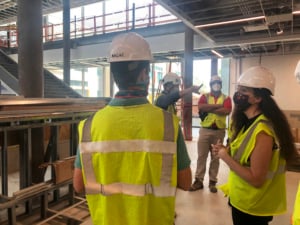Coping with COVID-19: Part II, Impacts on Schedule

Last week, we introduced our Coping with COVID-19 in the Construction Industry series. As we mentioned, over the next few weeks, we will be bringing you timely content from our COVID-19 Task Force on navigating the new challenges brought on by the coronavirus crisis. One of the timeliest topics to tackle for many projects currently being impacted by the continued spread of the coronavirus is scheduling, so that is what we will delve into today.
We have talked before about how essential proper schedule management is to a successful project completion, and that is even more true as we face this new normal. During this unprecedented time, it is inevitable that construction schedules will be impacted due to supply chain disruption, reduced workforce, material shortages, new safety protocols, reduced productivity, and other snowball effects. Understandably, owners are worried about the impact on their schedule and how that might translate to a potential increase in project costs and contractual issues. The following schedule guidelines and steps will help mitigate possible questions later in the year and into 2021.
HERE IS WHAT YOU CAN DO RIGHT NOW, AND IN THE COMING WEEKS, TO GET AHEAD ON MEETING THIS CHALLENGE.
Update the Schedule Now: MGAC has advised owners to update their schedule now to provide a benchmark going forward. Even if you are not sure of all of the eventual delays you may face, you will want to update this as best as you can and seek agreement on the revised schedule by all responsible parties. As the impact of the coronavirus continues to unfold, you will want to continue updating the schedule and stay in constant communication with all responsible parties. This continued effort will help to gather more data and facilitate more informed decisions.
Validate the Critical Path Forward: Defining the necessary critical path forward will help the owner to identify activities that must be completed on time in order to meet the key project milestones. Those critical activities that are highly susceptible to delay due to COVID-19 should become the highest priority items to address.
Breakdown the Schedule: Next, you will need to break down the schedule by capturing all activities associated with the various parties on the project. This will help forecast key milestones for the project, determine if the schedule is realistic and if re-sequencing is needed to mitigate the crew flow constraints. This task can also help identify key off-site design and procurement activities that can progress during closure and assist in a speedy recovery when work restarts.
Keep Detailed Records: Maintaining accurate records is critical in reaching a reasonable agreement for compensating impacted parties. This could include tracking labor hours, equipment and material availability, progress photographs, and meeting minutes. The more information is gathered, the easier potential change orders are to negotiate 12 months down the road.
HERE IS HOW TO ASSESS COVID-19 SCHEDULE DELAY CLAIMS BY THE CONTRACTOR.
The contractor may claim for time extensions due to the COVID-19 impact on project performance. Therefore, the owner needs to perform two key steps as noted below:
Entitlement: Additional activity delay may be possible due to COVID-19. However, the owner should consider if the activity was already late due to contractor error. If the activity was on time originally and was to finish before COVID-19 affected the project, this is likely not a reasonable claim that should result in owner payout.
Quantification: There are two types of delays: Pure Delays and Disruptive Delays.
Pure Delays are easy to quantify delays that include delay in procurement of material / equipment, delayed issuance of permits, or job shutdown. A fragnet (defined as the sequence of new activities that are proposed to be added to the existing schedule) can be inserted into the schedule to track the pure delay and also forecast the realistically achievable dates in the project.
Disruptive Delays include loss of productivity. These would stem from several factors like distance requirements, working in the staggered form, limited availability of labor, etc. This will lead to productivity loss and therefore delay the project schedule. In this scenario, a detailed resource-loaded schedule will assist in analyzing productivity loss quickly. However, several other methodologies can be used to substantiate a loss of productivity. The Measured Mile method is widely used and accepted in the construction industry to quantify disruptive delays. This method compares the productivity in the non-impacted period to productivity in the impacted period. The primary advantage of this method is that it uses the actual man-hours rather than the initially estimated man-hours. Therefore, the owner should track the labor hours to quantify Disruptive Delays. Other recognized methodologies include earned value analysis, comparison studies, and baseline productivity analysis.
FINALLY, HERE IS HOW YOU CAN MITIGATE SCHEDULE IMPACT DUE TO COVID-19.
The full impact of the pandemic is not yet clear at this stage, but we know there will be impacts on project performances and likely disputes with contractors and vendors for time extensions. Mitigating this risk will depend on key risk management practices: careful analysis to identify the risk, assessment of the potential impact, and a timely response to manage the risk.
Analysis: We recommend conducting a schedule workshop that will comprise of all the project participants, including key stakeholders, to define the short-term goals of the project. Later, it is essential to identify activities that are necessary to achieve those goals and determine if they may be impacted due to the COVID-19 pandemic. The impacts could include material delay, lack of labor forces, manufacturing closure, or delay in permitting.
This process will help the owner decide if a response plan is needed to mitigate the delay and under what circumstances the owner will merit additional time and cost to the project. In more severe cases, this pandemic may significantly impact markets where the need for the project is either no longer there or is significantly changed from its original business model and design. In this case, owners may need to suspend work.
Assess: Owners need to make sure that contractors are taking reasonable measures to mitigate any delays arising as a result of COVID-19. However, there are many variables in this pandemic that are not under the control of any parties. That means owners should request a response plan from the contractor that would address mitigation strategies. An owner should compare the response plan with the pre-COVID-19 schedule to make a go / no-go decision. Undoubtedly, there would be an increase in the cost of the project if the owner decides to accelerate or compress the schedule. Therefore, an owner needs to perform a risk / benefit analysis to assess the impact of time and money on the project. Our next installment of this series will dig into the cost side further.
Manage / Resolve: Finally, the owner should promptly document the progress of the project and identify the variation in the pre- and post-COVID-19 effects on the schedule. The owner should consider a virtual Pull Planning Session to encourage interaction with stakeholders and the contractor. Continuous monitoring and communication will keep all the parties on the same page and act as a catalyst for decision making at a higher level.
Stay tuned as we bring you the next pieces of this series.
Part III: Impacts on Cost
Part IV: Impacts on Contracts
Part V: Impacts on Future Planning









